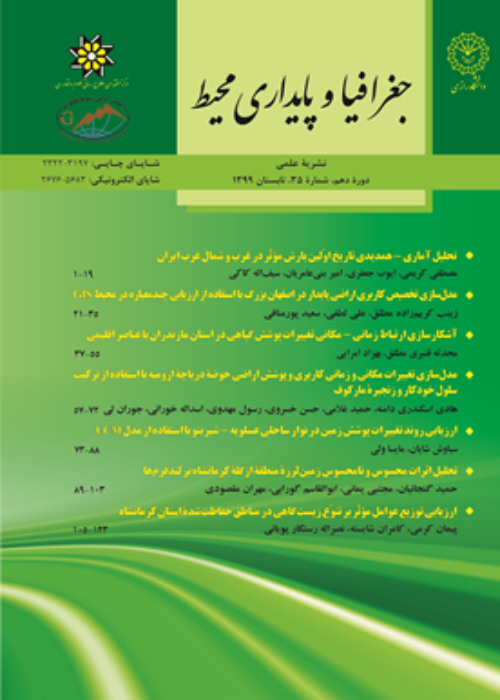Revealing the Consequences of Zayandeh Rood drying up and Vegetation Changes on the Temperature of the Earth's Surface in the Metropolis of Isfahan
Water stress is a major environmental issue and has a significant impact on the sustainability of urban areas worldwide. This study examines the changes in land surface temperature (LST) and their relationship with variations in vegetation cover during wet and dry periods in Zayandeh Rood. To accomplish this, Landsat TM, ETM, and OLI satellite images from three dry years (2001, 2009, and 2018) and three wet years (2005, 2006, and 2020) were used. The research findings indicate that, in 2006, when water was flowing in the river bed, vegetation cover decreased from 36% (201 km2) to 23% (km2) in 2018, when the river bed had no water. Over the last two decades, the Earth's surface temperature has increased. The highest average temperature was observed in 2018, at 40/4 degrees Celsius, and the maximum temperature in the dry years of 2001, 2009, and 2018 was higher than in the wet years of 2005, 2006, and 2020. The highest density of heat islands was observed in regions 2, 4, 5, 6, 7, 14, and east of region 15, which is concentrated on barren lands and then on urban areas. In the dry year of 2009, the total area of temperature classes 42-49 increased by approximately 12% compared to the dry year of 2001 and also increased by about 25% in 2018. In contrast, it was zero in the wet years of 2005 and 2006, and in 2020, it decreased by around 34% compared to 2018. Furthermore, urban development, which has grown by 7/3% over the past two decades, has contributed to the reduction of vegetation and intensified the urban heat island effect. Examining the average temperature changes at different distances from the Zayande Rood indicated that the temperature increased by about 1 degree Celsius with the distance from the river.
Climate change refers to unusual shifts in the earth's atmospheric climate that have far-reaching consequences across the globe. These shifts have led to an increase in the average temperature of the earth's surface, which has created numerous challenges for human security worldwide. Climate change has a significant impact on the hydrological cycle, causing changes in water resources, and leading to an increase in the frequency and intensity of droughts and floods. Water stress, one of the major environmental problems, has significant effects on the sustainability of urban areas across the world. The city of Isfahan has experienced many challenges, such as a rise in temperature, as a result of climatic changes and the drying up of the Zaynde-Rood River. Therefore, examining temporal and spatial changes in land use and their effects on the earth's surface temperature provides a clear picture of these changes. This analysis presents the behavior of the data before and after the drying of the Zayandeh Rood.
For this research, we used 6 Landsat satellite images during the summer season, as it has the maximum vegetation cover. We obtained the images of TM, ETM, and OLI sensors of the Landsat satellite from the Google Earth Engine system (https://code.earthengine.google.com). We calculated and extracted the LST of each image to investigate temperature changes in different areas of the city. We calculated the changes in vegetation area during the dry years of 2001, 2009, and 2018, and the wet years of 2005, 2006, and 2020, and their effects on the surface temperature using the NDVI index. We also calculated the rate of urban growth and expansion using the NDBI index. All the calculations, graphs, and analyses were done using ArcGIS Pro and Excel.
The catchment area of Zayandeh Rood has experienced drought in recent years, causing the water flow of Zayandeh Rood to stop flowing continuously in the metropolis of Isfahan. This has led to significant changes in the natural vegetation and planting in terms of land area. The complete interruption of the river water flow has affected the amount of temperature, evaporation, and transpiration of plants in the Isfahan metropolis, which has subsequently affected the extent of vegetation cover. Research shows that in 2006, when water was flowing in the riverbed, the vegetation area decreased from 36% (201 km2) to 23% (126 km2) in 2018, when the riverbed was devoid of water. This was due to the expansion of residential areas and the change of agricultural uses to residential. Over the last two decades, the temperature of the earth's surface has increased, with the highest average temperature observed in 2018 at 40.4 degrees Celsius. The maximum temperature in the dry years of 2001, 2009, and 2018 was higher than the wet years of 2005, 2006, and 2020. The highest density of heat islands was observed in regions 2, 4, 5, 6, 7, 14, and east of region 15, which is concentrated on barren lands. The total area of the temperature classes 42-49 in the dry year of 2009 increased by about 12% compared to the dry year of 2001 and also in 2018 by about 25%, while in the wet years of 2005 and 2006, it was zero. In 2020, compared to 2018, it decreased by about 34%, and in 2020 compared to 2009 and 2018, it increased by about 11% on average, indicating an increase in temperature in dry years and a decrease in temperature in the wet years. Urban development has increased by 3.7% over the past two decades, which has contributed to reducing vegetation and intensifying the urban heat island effect. Examining the average temperature changes at different distances from the Zayande Rood showed that the temperature increased by about 1 degree Celsius with the distance from the river.
The analysis of NDVI data revealed that vegetation significantly decreased during dry years compared to wet years. The area of weak vegetation increased by 3%, indicating that water stress led to a shift towards vegetation types that require less water. The examination of the earth's surface temperature also showed a clear difference between dry and wet years. During dry years, LST values were generally higher than in wet years, with an average temperature of 40.4 degrees Celsius in 2018. In contrast, wet years showed lower LST values, with an average temperature of 31.4°C in 2006. The distribution of LST was also different between dry and wet years, with dry years characterized by a wider range of LST values, indicating the urban heat island effect. Water stress emerged as a crucial factor affecting vegetation and LST. Additionally, urban development, which has increased by 3.7 percent over the past two decades, has contributed to reducing vegetation and intensifying the urban heat island effect.
- حق عضویت دریافتی صرف حمایت از نشریات عضو و نگهداری، تکمیل و توسعه مگیران میشود.
- پرداخت حق اشتراک و دانلود مقالات اجازه بازنشر آن در سایر رسانههای چاپی و دیجیتال را به کاربر نمیدهد.




